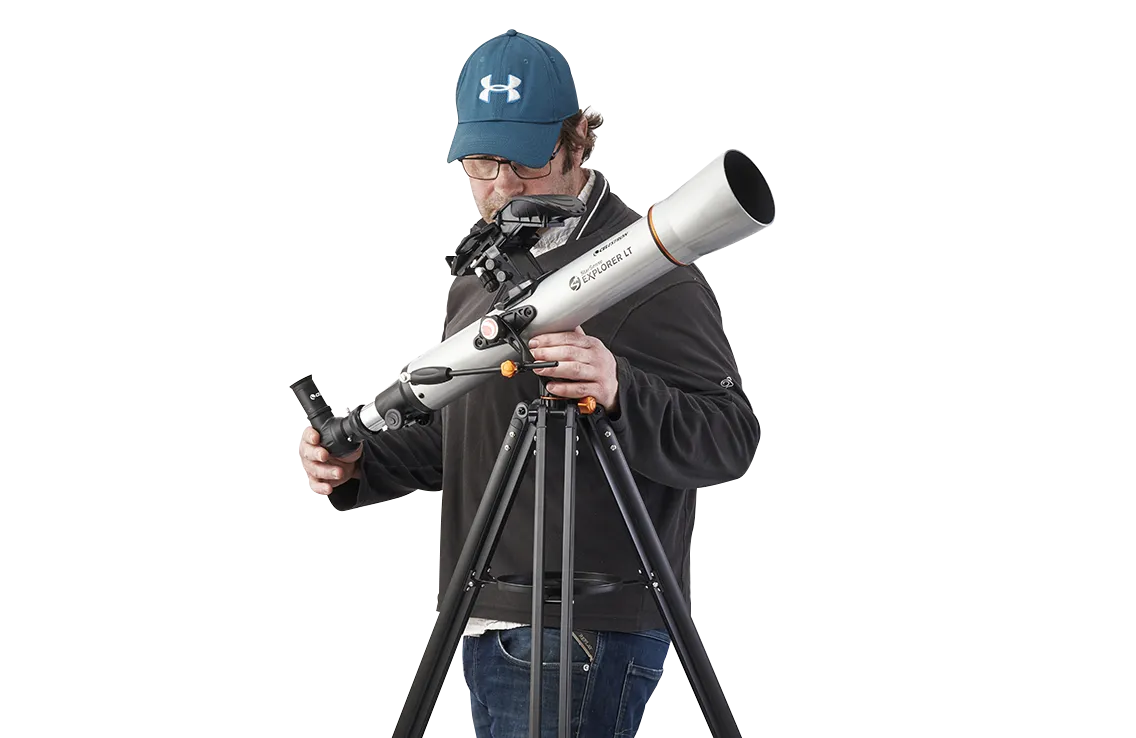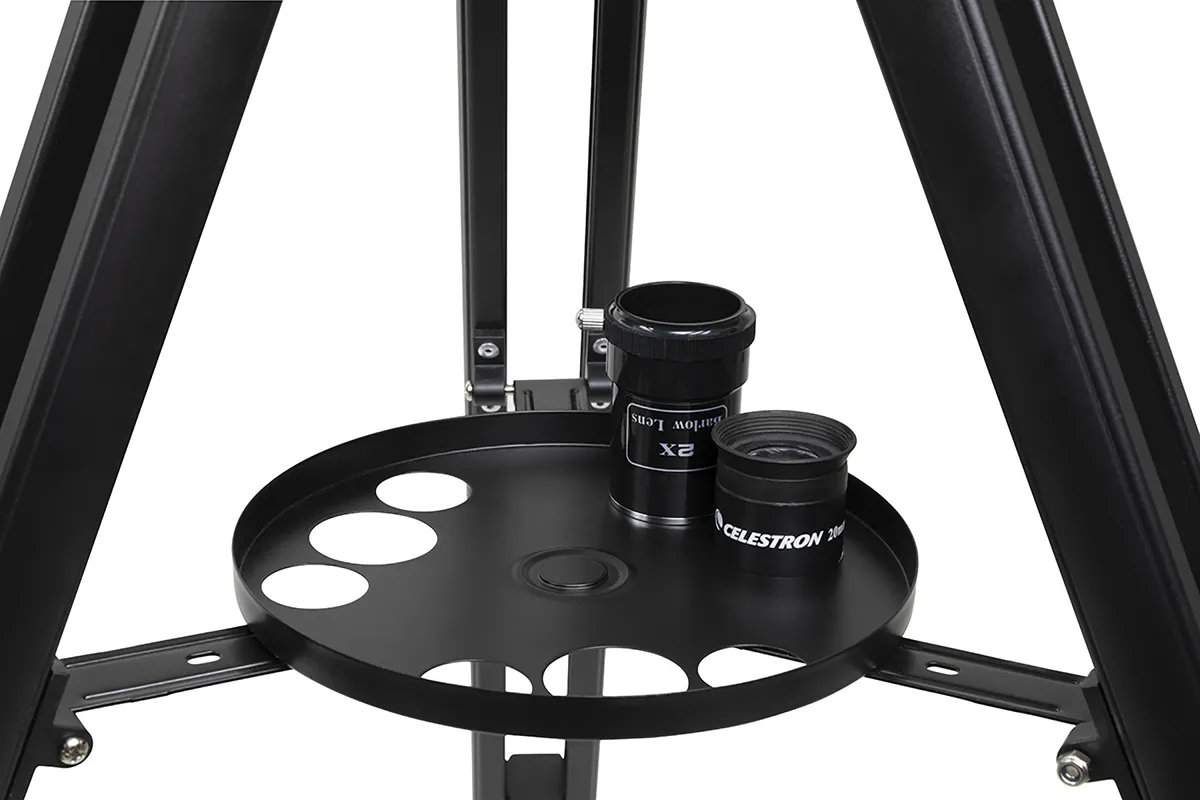Relatively small telescopes often get a bad press, sometimes for having low light grasp and not giving good views of the night sky. My own experience suggests otherwise, having used a 60mm refractor to spot up to 70 of the well-known Messier deep-sky targets when I began my astronomical journey.
We need to appreciate that these telescopes won’t give a ‘Hubble view’, and it’s with this in mind that we approached the new StarSense Explorer range, with our review taking a look at the first and smallest available, the LT 70AZ.
The LT 70AZ is a refractor with a 70mm diameter front objective lens with fully coated optics and a focal length of 700mm, giving a focal ratio of f/10.
The aluminium tube is sturdy, quite lightweight and is mounted on a basic altaz fork mount with a slow-motion control for fine adjustment of the altitude, while general adjustment is made by loosening the thumbscrew.
Azimuth adjustment is made via another thumbscrew but there is no fine adjustment.Indeed, we found no need for one, being able to nudge the azimuth to fine tune it.
Focusing is by a basic rack and pinion focuser and it can take 1.25-inch format eyepieces and accessories.
This telescope features in our lists of the best telescopes for beginners and best budget telescopes

The telescope is supplied with two eyepieces, 25mm and 10mm, along with a 2x Barlow lens and an erect image star diagonal. A simple red dot finder and tripod with accessories tray completes the system.
However, an unusual and unique difference to the StarSense Explorer system is a strange looking contraption on top of the telescope tube.This is the StarSense Explorer phone dock, which incorporates a smartphone holder and a mirror.
It turns a simple, basic manual telescope into one that can easily locate objects via a touchscreen phone and the StarSense app (suitable for Android 7.1.2 and higher, and iPhone 6 upwards).
With our iPhone XR docked and using the StarSense app we were able to locate the brighter targets quite quickly.
We took a tour of a wide variety of deep-sky targets, some suggested by the app as a blue circle pointing them out, or via a tour menu of ‘Tonight’s Best’, or a secondary selection of more challenging targets.
Relatively bright star clusters such as the Double Cluster, Pleiades, Beehive Cluster and the three Messier clusters in Auriga were impressive, with the colourful red giant stars scattered in and among the Double Cluster being especially noticeable.
The Orion Nebula was a little low for us but still showed plenty of nebulosity with the 25mm eyepiece, while bumping up the magnification with the 10mm revealed the four stars of the Trapezium Cluster at the heart of the nebula.

Indeed, we had good views of the brighter and more well-separated double and multiple, with Castor and Algieba each well split with a 10mm view.
The view was also rewarding using a 2x Barlow. We tried the multiple star system Iota Cassiopeiae and could split it into two, while at the highest magnification there was a hint of a third companion.
Galaxies are in the main much fainter, but we could pick out the five Messier galaxies in the constellation of Leo, M81 and M82 in Ursa Major, while globular clusters such as M3, M62 and M13 were like fluffs of cotton wool.
Later in the month we viewed Venus before it approached the Pleiades. It was bright and we found that the combination of the 10mm eyepiece and 2x Barlow lens allowed us to see its almost half phase.
On the evening before its closest approach to the Pleiades we were able to frame Venus and the cluster in the view of the 25mm eyepiece.
As long as you don’t have high expectations of stunning deep-sky observations, you’ll find that the StarSense app turns this manual system into a virtual Go-To system with plenty to explore and enjoy.
Overall, we were pleased to discover that the LT 70AZ did a commendable job, providing plenty of pleasing views.
Starsense app
Although the StarSense smartphone adaptor and mirror holder give this otherwise normal-looking refractor a rather unusual appearance, it will transform your observing sessions.
Simply download the StarSense app from Google Play or the Apple app store and insert your smartphone in the holder.
Next, you have to align the smartphone with the telescope when you start up the app.
Once this was done we were pleased to discover that it stayed aligned for the sessions in which we used the scope.
The smartphone app is the core of the system: it plate solves the view of the sky the phone camera sees reflected in the mirror, allowing it to work out where it is pointing.
This enables the planetarium part of the app to show you the way via onscreen arrows to a highlighted or chosen target. Move the telescope manually until you are almost on target, before leaving the scope for it to refine its position.
Then you can fine tune the position so that the onscreen indicator box turns green to indicate you are on target. And it works, with all of our targets placed close to the centre of the target box and in the eyepiece too.

Refractor tube
The optics are housed in an aluminium tube of 812.8mm length with the focuser fully racked out and 690mm with it fully racked in. The tube is 76mm in diameter with a fixed dew shield that prevents the front objective lens from misting up. The whole tube is very lightweight, weighing only 1.63kg.
Mount
The mount is a simple altaz design allowing movement up and down and sideways. There is a single slow motion control for fine tuning the altitude via an adjustable rod with rough adjustment done via a simple knob. Motion in azimuth is achieved by loosening the azimuth knob and gently rotating the whole telescope.
Tripod
The black, aluminium tripod is lightweight at 1.72kg and adjustable to a maximum height of 1.32m, giving a good range of adjustment for viewers of all ages. It comes with a simple but effective accessories tray that can take the eyepieces and 2x Barlow lens, keeping them handy for use.
Accessories
Two 1.25-inch fit eyepieces of 25mm and 10mm, giving magnifications of 28x and 70x, are provided along with a 2x Barlow lens that doubles the magnification of each, plus an erect image star diagonal which is useful in an altaz system. A StarPointer red dot finder is also provided, which helps with initial alignment.
Optics
The front objective of the StarSense LT 70AZ is a 70mm diameter lens with a focal length of 700mm, which gives a focal ratio of f/10. The lens is fully coated to improve light transmission for brighter, crisper views and gathers 100x more light than a human eye.
Vital stats
- Price £135
- Optics 70mm fully coated objective lens
- Focal length 700mm, f/10
- Mount Manual altazimuth mount with smooth, altitude slow-motion control
- App control StarSense app with StarSense sky recognition technology and planetarium
- Extras StarSense dock for your smartphone, 25mm and 10mm eyepieces,2x Barlow lens, 90º erect image diagonal, StarPointer red dot finderscope
- Weight 3.35kg
- Supplier David Hinds Ltd
- Tel +44 (0)1525 852696
- www.dhinds.co.uk
This review originally appeared in the June 2020 issue of BBC Sky at Night Magazine.
